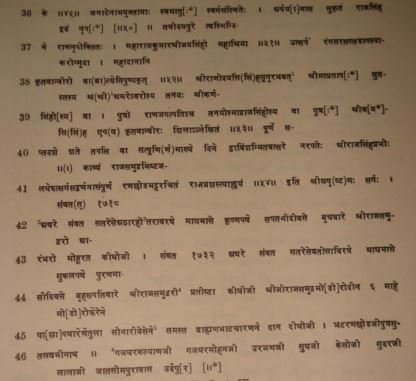| |
South
Indian Inscriptions |
| |
|
|
|
Contents |
|
Index
|
|
Introduction
|
|
Contents
|
|
List of Plates
|
|
Additions and Corrections
|
|
Images
|
|
Contents |
|
Chaudhury, P.D.
|
Chhabra, B.ch.
|
|
DE, S. C.
|
|
Desai, P. B.
|
|
Dikshit, M. G.
|
|
Krishnan, K. G.
|
|
Desai, P. B
|
|
Krishna Rao, B. V.
|
|
Lakshminarayan Rao, N., M.A.
|
|
Mirashi, V. V.
|
|
Narasimhaswami, H. K.
|
|
Pandeya, L. P.,
|
|
Sircar, D. C.
|
|
Venkataramayya, M., M.A.,
|
|
Venkataramanayya, N., M.A.
|
|
Index-By A. N. Lahiri
|
|
Other
South-Indian Inscriptions
|
|
Volume
1
|
Volume
2
|
|
Volume
3
|
Vol.
4 - 8
|
|
Volume 9
|
Volume 10
|
|
Volume 11
|
Volume 12
|
|
Volume 13
|
Volume
14
|
|
Volume 15
|
Volume 16
|
|
Volume 17
|
Volume 18
|
|
Volume
19
|
Volume
20
|
|
Volume 22
Part 1
|
Volume
22
Part 2
|
|
Volume
23
|
Volume
24 |
|
Volume
26
|
Volume 27 |
|
Tiruvarur
|
Darasuram
|
|
Konerirajapuram
|
Tanjavur |
|
Annual Reports 1935-1944
|
Annual Reports 1945- 1947
|
|
Corpus Inscriptionum Indicarum Volume 2, Part 2
|
Corpus Inscriptionum Indicarum Volume 7, Part 3
|
|
Kalachuri-Chedi Era Part 1
|
Kalachuri-Chedi Era Part 2
|
|
Epigraphica Indica
|
Epigraphia Indica Volume 3
|
|
Epigraphia
Indica Volume 4
|
Epigraphia Indica Volume 6
|
|
Epigraphia Indica Volume 7
|
Epigraphia Indica Volume 8
|
|
Epigraphia Indica Volume 27
|
Epigraphia Indica Volume 29
|
|
Epigraphia Indica Volume 30
|
Epigraphia Indica Volume 31
|
|
Epigraphia Indica Volume 32
|
Paramaras Volume 7, Part 2
|
|
Śilāhāras Volume 6, Part 2
|
Vākāṭakas Volume 5
|
|
Early Gupta Inscriptions
|
|
Archaeological
Links
|
|
Archaeological-Survey
of India
|
|
Pudukkottai
|
|
|
EPIGRAPHIA INDICA
RAJAPRASASTI INSCRIPTION OF UDAIPUR.

Slab X ; Canto IX
[Metres : vv. 1, 14, 15, 34, 46 Śārdūlavikrīḍita ; vv. 2-13, 16, 18-32, 36, 38-40, 42, 43, 45, 48
Anushṭubh ; vv. 17, 37 Upajāti ; v. 33 Gīti ; v. 41 Mandākrāntā ; vv. 44, 47 Sragdharā.]

___________________________________________________________
[1] Sandhi is not observed here.
[2] From here to the end the language is the local dialect.
[3] This phonetic change of Hindi śō into hō in Rājasthānī may be noted.
[4] Rī is the indicative of the genitive same as Hindi kī.
[5] The sense is that it took 6days to go round the lake, and when Rājasiṁha returned, he performed the
tulā ceremony.
[6] The names of the masons are also given above, towards the close of Slabs III, VI and VIII as well as below
at the end of Slab XXV
|
\D7
![]()
|







